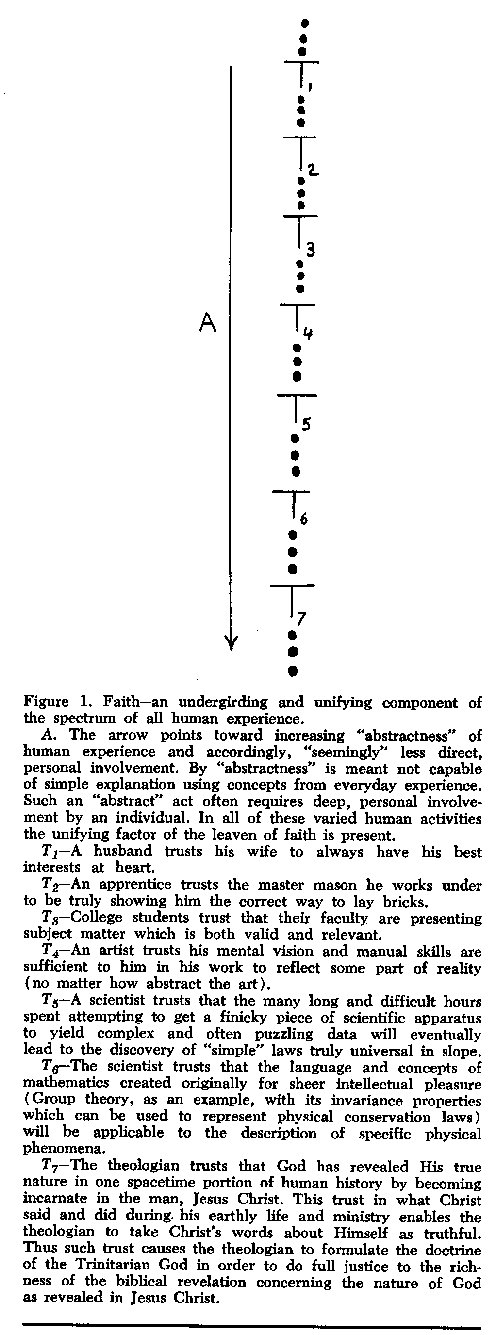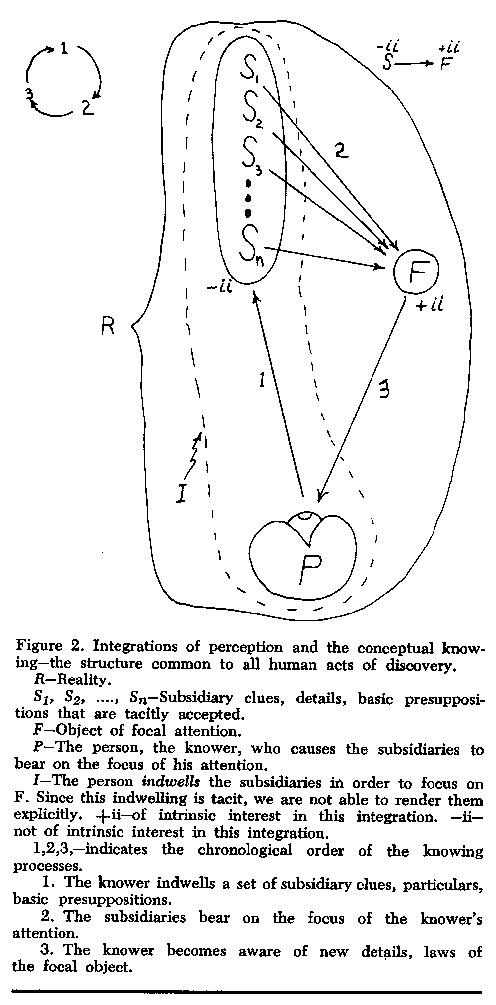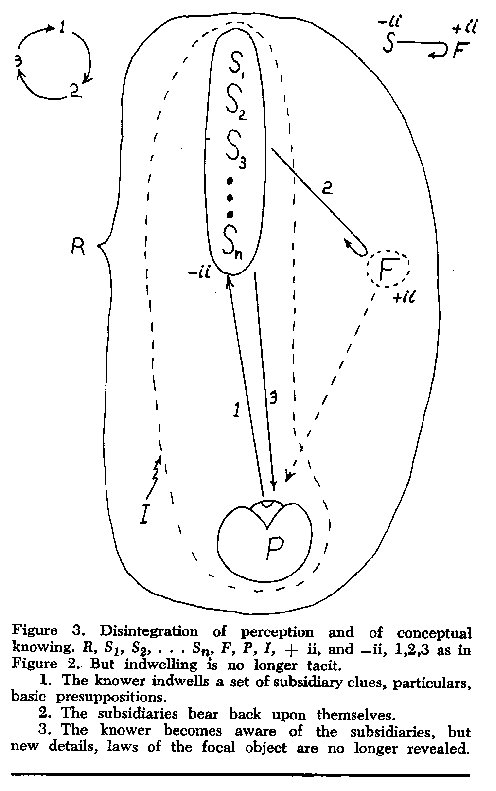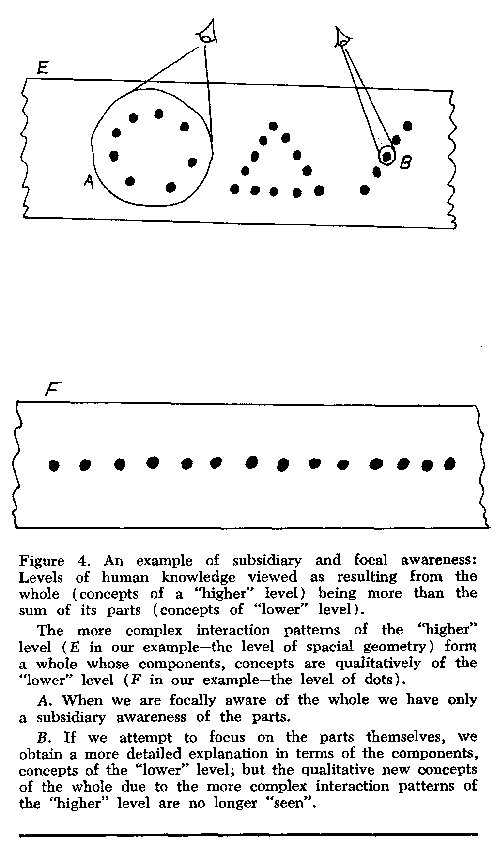 Science
in Christian Perspective
Science
in Christian Perspective Science
in Christian Perspective
Science
in Christian Perspective
Personal Knowledge:
An Epistemology of Discovery
W. JIM NEIDHARDT
Department of Physics
New Jersey Institute of Technology
Newark, New Jersey 07102
From: JASA 29 (September 1977): 118-123.
Two Biblical attitudes, faith in the sense of deep commitment and love in
the sense of being self-giving, are both seen to be essential parts of any successful human activity whether in everyday human relations, religious experience,
artistic creation, philosophical speculation, or scientific work, Faith is seen as a
leavening component of all human experience; as Michael Polanyi has ably
pointed out, all human acts of discovery are rooted in a common structure of
tacit commitments. The basic presuppositions of Polanyi's epistemology are
summarized and considered in the context of scientific knowing. if tacit, personal
commitments are a necessary part of the creative process in science, then analogous acts of tacit commitment are present in the more person-centered areas of
human knowledge as art, philosophy, and religion.
Personal Commitment: The Coupling of Faith and Love
In the first article of the Nicene Creed Christians confess their faith in the "one God-The Father Almighty, Maker of Heaven and Earth, and all things, visible and invisible." This confession contains a profoundly biblical theme-God's guarantee of the trustworthiness and wholeness of creation. The material of which the entire cosmos is made (Heaven and Earth) is an orderly continuum, interwoven and structured together. The very nature of it, its wholeness and trustworthiness, is a revelation of the uniqueness, the oneness, and the totality of God in what He has brought into being. The Creation is not God but has implanted in it the mark of His nature. It is therefore quite appropriate that we examine God's revelation, as expressed in the Bible, for general principles that apply to the interaction of humans with all reality.
There are two key attitudes expressed throughout the whole Bible that are essential parts of any successful human activity, whether the endeavor be in everyday human relations, religious experience, artistic creation, philosophical speculation, or scientific work. The biblical attitudes that I am referring to are:
1. Faith in the sense of deep commitment to God, other humans, oneself, and one's vocation.
2. A deep self-giving love with respect to God, other humans, oneself, and one's vocation.
These two attitudes are intertwined; both must be present for creative accomplishment to take place. Furthermore, the Judeo-Christian tradition teaches that the capacity to express trust and love towards both people and concepts stems from man reflecting, however marred, the image of the infinite-personal creator God.
Faith is a word that is badly misunderstood by our present age. Faith can be defined as an act of affirmation, of belief, or of commitment that leads to positive action by a person. This act of affirmation takes place through a filter or matrix of presuppositions that one trusts in even though the evidence for such trust is not right before one's eyes. Faith is not, however, a leap in the dark; true faith is not blind assent. True faith always arises out of the totality of one's prior and present experience.
Faith consists not in what can be proved by results. Faith precedes results; faith motivates us towards results. Contrary to much popular opinion, faith always without exception precedes logic, intellect, judgment, reason, and the seeking of experimental data (and then leads the knower beyond them). You cannot begin any personal encounter, mathematical analysis, or experimental work in science (as typical examples) without some prelogical notions (presuppositions) that you commit yourself to by faith, Figure I shows bow acts of faith play the role of leaven in all human experience, from simple everyday life to complex artistic, scientific, or religious experience. The ability to express faith, to be able to place trust in people and concepts when all seems to be going wrong is a uniquely personal, human attribute.
In what ways does love join with faith in any act of human discovery? This question has been thoughtfully answered in the recent work of Richard J. Pendergast1 who has with great insight pinpointed
Faith consists not in what can be proved by results. Faith precedes results; faith motivates us towards results.
the universality and the deeply personal, interwoven structure of the faith-love relationship. He points out that just as a religious act of faith is a free act,
. . . so the natural act of faith one makes in order to understand scientific truth is a free choice. Among the implicits which undergird our acts of understanding are desires, our 'intellectual passions' as Polanyi calls them. The creative act which calls into being a new scientific theory, or even the act by which a person assimilates an established theory is not completely determined by the data. Like the constructions of art and music, these constructions are partly determined by what the person wants. Scientific creation is therefore a moral act, an act which expresses the love of beauty and order which motivates the scientist. In his famous essay on the psychology of mathematical invention, Poincarel suggests that the mathematician's sense of beauty is one of the most powerful enabling factors in the creation of new mathematics. This sense of beauty clearly involves the will's attraction by the intellectual good. The same is true in all fields. Intellectual acts are not only acts of understanding, but also acts of love, though the relative weight of the two components can vary greatly in different fields of endeavor (Pendergast, p. 98) . . .
In seeking understanding of any part of reality. . . we take a stand toward it, put ourselves into a
certain relationship to it. In other words, we decide
whether this thing is good or bad for us, whether we
love it or bate it, . . . To contemplate it is not only to
know it as something distinct from us but also to know
it as related to us. This relationship is either one of
harmony and peace or of incompatibility and disquiet.
The same external object will be symbolized and known
quite differently depending on whether we love it or
hate it. This is obvious, of course, in the case of human
beings. We can't really know another person unless we
love him. This is true even in the case of someone like
Hitler. The one who knows such a person best is the
one whose hatred of his deformities is situated within
the context of a more fundamental love of his basic
humanity and a painful awareness of the way it has
been perverted by evil. The same thing is true in a less
obvious way even of scientific or mathematical knowledge. The knowledge of physical or mathematical structures cannot be separated from an appreciation of their
beauty. In fact, as Poincar6 suggested, those who do not
appreciate them will not be able to discover them or
understand them well. The person who 'hates math'
brings forth a distorted and imperfect symbol of the
reality with which be is in contact (Pendergast, p.
119) . . .
Complete Objectivity in Science is an Illusion: We
Know Far More Than We Can Tell!3
The average scientist is disturbed upon first hearing
Polanyi's assertion that complete objectivity in science
is an illusion. How can a man who made significant
contributions to physical chemistry disown his beritage? How can a scientist say that experimental evidence is not important? But this is jumping the gun,
for it ignores what Polanyi has actually written in
Personal Knowledge
and many other books and articles
-it is not first listening to the evidence that Polanyi
wishes to introduced Polanyi is not attempting to
downgrade the seeking of clear-cut experimental evidence. What Polanyi is really concerned with are the

theoretical interpretations of experimental evidence and the basic question of why certain sets of observations are made and considered significant rather than others (originality in science is partly seeing in existing data relationships that others have not seen). Science is not the collecting of data on a random or wholesale basis and the subsequent stringing out of possible relationships in telephone book fashion. What Polanyi has created, to my mind, is really a model of scientific discovery and this same pattern can be extended to cover all acts of human discovery. Polanyi is concerned primarily with the development of a perspective that emphasizes the unity of the knowing process in all human activity, science, art, philosophy, and religion. All knowing is similar in some ways even though there are distinctions in the objects known in science, art, and religion.
The central presuppositions of Polanyi's epistemology are:
1. We are as knowers partly conditioned by our environment and genetic inheritance; nevertheless, we can actively commit ourselves to altering our environment; we can take actions not determined by our environment and genetic inheritance.
2. As personal beings we can actively commit ourselves to the affirmation of our own existential reality (the self) and the affirmation that there is a consistent structure to that reality which is outside us. These personal acts of commitment are to be clearly distinguished from our subjective states in which we merely endure our feelings.
This distinction establishes the conception of the personal, which is neither subjective or objective. Insofar as the personal submits to requirements acknowledged by itself as independent of itself, it is not subjective, but insofar as it is an action guided by individual passions, it is not objective either. It transcends the disjunction between subjective and objective.43. Reality outside us has a structure to which I entrust myself (I commit myself in advance-for I do not clearly perceive the whole structure) in the hope that through such acts of responsible commitment to perceiving such an open-ended, independent, external structure I may come to know something more about it. I am indwelling a set of commitments about reality in order to gain further knowledge. It should be noted that Polanyi strongly argues for the validity of supposedly intangible realities.
For surely, there are a great number of things our knowledge of which dissolves if we look at them in a thoroughly detached manner. The meaning of a word vanishes if I cease to mean anything by it; the proof of a mathematical theorem dissolves if I cease to trust it; and likewise, a moral ideal dissolves if I stop respecting it. I cannot know that someone, say Lincoln or Gandhi, was a great man unless I revere him. You need reverence to observe human greatness, just as you require a telescope to observe spiral nebulae. But reverence is not an objective approach in the tradition of Newton, and hence our ideals-along with the greatness of men who embody these ideals-must cease to be visible if they are approached in this Newtonian sense.5
4. The claims of both extreme existentialists and positivists are rejected. In particular, existentialism's claim that knowledge of myself can be gained independent from any external reality structure is denied, as well as positivism's claim that knowledge can be gained by completely impersonal means.
Positivism claims that scientific truth is impersonal, possessing an inescapable quality in that discovering


In recent work Polanyi has pointed out that a structure from subsidiary to focal awareness is common to many types of perceptive acts. In any act of knowing we tacitly rely on subsidiary details which point toward the greater whole of the focal target.
Subsidiaries exist as such by bearing on the focus to
which we are attending
them. In other words, the
functional structure of from-to knowing includes jointly a subsidiary 'from' and a focal 'to.' But this pair is
not linked together of its own accord. The relation of a
subsidiary to a focus is formed by the act of a person
who integrates one to the other. The from-to relationship Iasts only as long as a person, the knower, sustains
this integration.8
In Gestalt psychology, this is the way the subsidiary "framework" (the clues, the particular details, the matrix of presuppositions we are committed to) enables us to perceive a whole (what is focussed upon). The subsidiary particulars that a person tacitly indwells, is committed to, point toward the whole of which one becomes focally aware of. If we explicitly 11 refocus" on the subsidiary "framework" through which we have perceived the focal whole, it is no longer seen, our perception of its structure has disintegrated.
Polanyi's discussion of two examples of from-to knowing is now included:
1. . . . the familiar case of tactile cognition: of using a probe to explore a cavity, or a stick to feel one's way in the dark. Such exploration is from-to knowing, for we attend subsidiarily to the feeling of holding the probe in the hand, while the focus of our attention is fixed to the far end of the probe, where it touches an obstacle in its path . . . 9
2.... the acceptance and use of the intellectual tools offered by an interpretative framework, in particular by the textbooks of science. While we rely on a scientific text, the text is not an object under scrutiny but a tool of observation. For the time being we have identified ourselves with it; and as long as our critical faculties are exercised in a from-to way by relying on this text, we shall continue to strengthen our uncritical acceptance of it.
There is no mystery about this. You cannot use your spectacles to scrutinize your spectacles. A theory is like a pair of spectacles; you examine things by it, and your knowledge of it lies in this very use of it. You dwell in it as you dwell in your own body and the tools by which you amplify the power of your body. It should be clear that someone who is said to be 'testing' a theory is in fact relying, in this subsidiary and very uncritical way upon other tacitly accepted theories and assumptions of which he cannot in this action be focally aware.10
Polanyi strongly emphasizes that much of our knowledge is tacit as it is inescapably indeterminate. He points out that:
. . . the bearing that empirical knowledge has upon reality is unspecifiable. There is nothing in any concept that points objectively or automatically to any sort of reality. That a concept relates to a reality is established only by a tacit judgment grounded in personal commitments, and we are unable to specify all these personal commitments or to show how they bring a given concept to bear upon reality and thus enable us to trust it as knowledge. We are unable to do this because we are dwelling in these basic commitments and are unable to focus our attention upon them without destroying their subsidiary function. The coherence that we see when we dwell in the particulars that make it up we see focally. Its particulars (the clues we dwell in) we see only subsidiarily. When we focus upon them making them explicit entities we change their phenomenal character, and we find that they do not, in their new guise, logically imply-i.e., imply explicitly or in a detached manner-the reality we do find them to imply through an indwelling tacit inference.11
. . . our dwelling in the particulars, basic presuppositions, the subsidiary clues, results in their synthesis into a focal object only by means of an act of our imagination-a leap of a logical gap; this does not come

about by means of specifiable, explicit, logically operative steps. The depth seen through a stereoscope is a new phenomenal experience, not deducible in its unique phenomenological character from the clues that the process of tacit integration integrates, just as the heliocentric concept of the planets 'seen' by Copernicus was a new conceptual experience not deducible from his available data. We can only point to the existence of tacit integration in our experience. We must be forever unable to give it an explicit specification . . . 12
. . . These integrations might also be called self-centered integrations because they are made from the self as a center (which includes the subsidiary clues in which we dwell) to the object of our focal attention . . . . 13
If we accept Polanyi's epistemology as valid, we are entitled to ask the question:
How can a perspective that perceives all truth as
gained by tacit (or even explicit) intellectual commitment avoid the charge of not really being in contact with truth, of being in error? I believe that Polanyi would ultimately answer that there can be no
acquiring of genuine knowledge without risk of error.
We make a working commitment to the authority of
what we perceive to be truth independent of us and
acknowledged as such by other responsible knowers of
similar training, or if not recognized by others yet we responsibly argue for its validity on the premise
of our common commitments. Part of our responsibility
to the authority of external truth is an acknowledgment of risk-a willingness to look for and correct
error. Awareness of risk is not itself a denial that
11
absolute truth" exists or that we may be really in
contact with such truth. It is rather that our relationship to it is one of working commitment to its authority
-not of absolute certainty. Reality is the final judge
of all truth.
Figures 2 through 4 schematically illustrate the structure common to all acts of discovery. Figure 2 shows how subsidiary clues and presuppositions enable us to focus upon and recognize bidden features of reality. Figure 3 shows how such acts of perception and conceptual knowing disintegrate if we attempt to focus on the subsidiary clues and presuppositions themselves. Figure 4 shows an example of subsidiary and focal awareness arising due to different levels of human understanding.
ConclusionPositivistic philosophers have portrayed scientific research as completely impersonal, yielding knowledge that is truly "true" devoid of all personal involvement and metaphysical assumptions. What Polanyi has done is to show that scientific knowledge is not completely objective, free of all personal involvement; rather scientific knowledge has its personal component whose structure it shares in common with other human activities. All knowing, whether the subject area be science, philosophy, art, religion, or everyday experience, shares a common structure; acts of discovery are embedded in matrices of personal commitments which the person indwells in order to explore reality thereby bringing about new knowledge. Augustine's insight is still sound: "Unless you believe you shall not understand." Once more:
...
we must recognize belief as the source of all knowledge. Tacit assent and intellectual passions, the shaping of
an idiom and of a cultural heritage, affiliation to a likeminded community: such are the impulses which shape
our vision of the nature of things on which we rely for
our mastery of things. No intelligence, however critical
or original, can operate outside such a fiduciary framework. . . . The process of examining any topic is both
an exploration of the topic, and an exegesis of our fundamental beliefs in the light of which we approach it; a
dialectical combination of exploration and exegesis. Our
fundamental beliefs are continually reconsidered in the
course of such a process, but only within the scope of
their own basic premises.14
To accept commitment as the framework within which we may believe something to be true, is to circumscribe the hazards of belief. It is to establish the conception of competence which authorizes a fiduciary choice to be made and timed, to the best of the acting person's ability, as a deliberate and yet necessary choice. The paradox of self-set standards is eliminated, for in a competent mental act the agent does not do as he pleases, but compels himself forcibly to act as he believes he must. He can do no more, and he would -evade his calling by doing less. The possibility of error is a necessary element of any belief bearing on reality, and to withhold belief on the grounds of such a hazard is to break off all contact with reality. The outcome of a competent fiduciary act may, admittedly, vary from one person to another, but since the differences are not due to any arbitrariness on the part of the individuals, each retains justifiably his universal intent. As each hopes to capture an aspect of reality, they may all hope that their findings will eventually coincide or supplement each other.15
Accordingly, as there is only one truth, one external reality, our beliefs are continually to be evaluated and assessed as to bow well our matrix of commitments leads to a picture, a model, or a theory that is in agreement with external reality. The only way I can speak of my description of external reality is by making up my own mind with respect to it; in doing so I either rely on an existing consensus as a clue to the truth, or else I may dissent from it for my own reasons. In either case my answer will be made with universal intent; I will state what I believe to be the truth, and what the consensus ought therefore to be. This position is clearly not solipsistic since it is based on a belief in an existence of an external reality and in the existence of other persons who can likewise approach the same reality.
lRichard J. Pendergast, Cosmos, Fordham University Press,
New York, 1973.
2Henry Poincare',
Mathematical Creation, Mathematics in the
Modern World, W.
H. Freeman and Company, San
Francisco, 1968.
3Michael Polanyi in the course of his long academic career
in both the physical and social sciences has elaborated
upon this thesis in great detail. The rest of this paper
summarizes his key ideas which have been developed
in the following list of books:
B. The Study of Man, The University of Chicago Press, Chicago, 1959.
C. Science, Faith, and Society, The University of Chicago Press, Chicago, 1964.
D. Knowing and Being, edited by Marjorie Grene, The University of Chicago Press, Chicago, 1969.
E. Meaning, with Harry Prosch, The University of Chicago Press, Chicago, 1975.
4Polanyi, Ibid. (A), p. 300.
5Michael PoIanyi, "Scientific Outlook: Its Sickness and Cure", Science, March 1957, Vol. 125, No. 3246, p. 481.
6PoIanyi, Op. Cit. book and page reference lost.
7Polanyi, Ibid. (A), p. 16.
8Polanyi, Ibid. (E), pp. 37-38.
9Polanyi, Ibid. (E), p. 35.
10Polanyi, Ibid. (E), pp. 36-37.
11Polanyi, Ibid. (E), p. 61.
12Polanyi, Ibid. (E), p. 62.
13Polanyi, Ibid. (E), p. 71.
14Polanyi, Ibid. (A), pp. 266-267.
15Polanyi, Ibid. (A), p. 315.